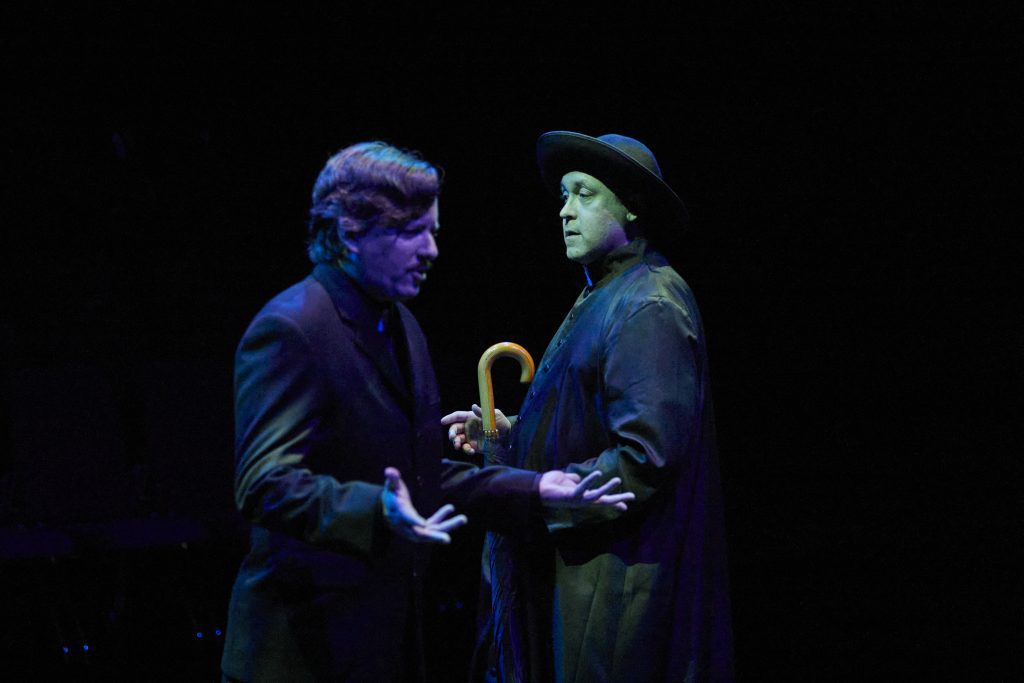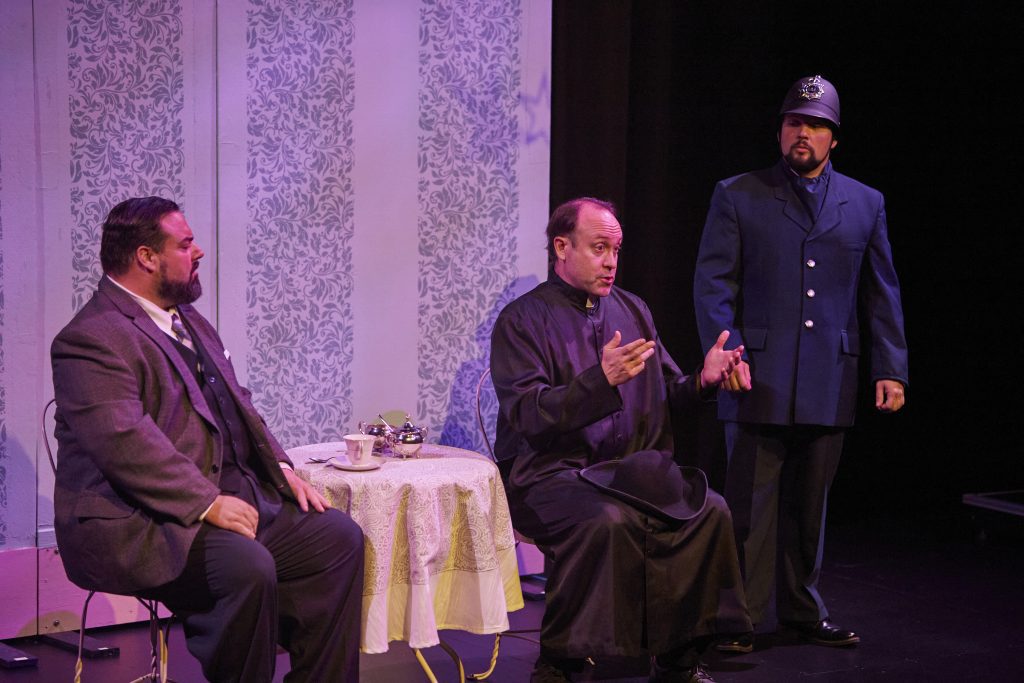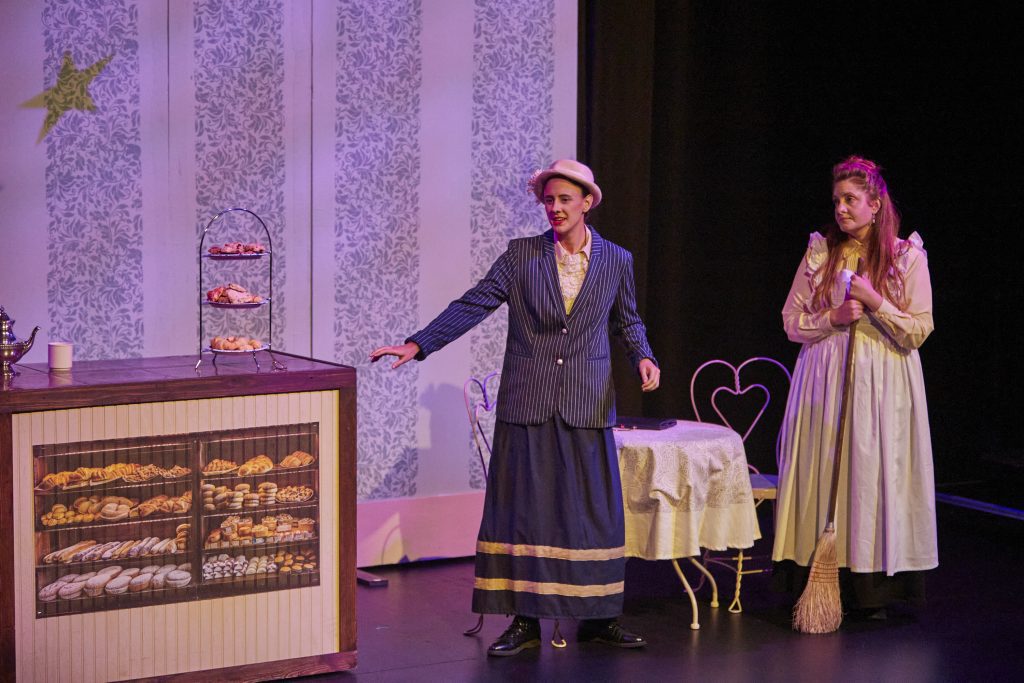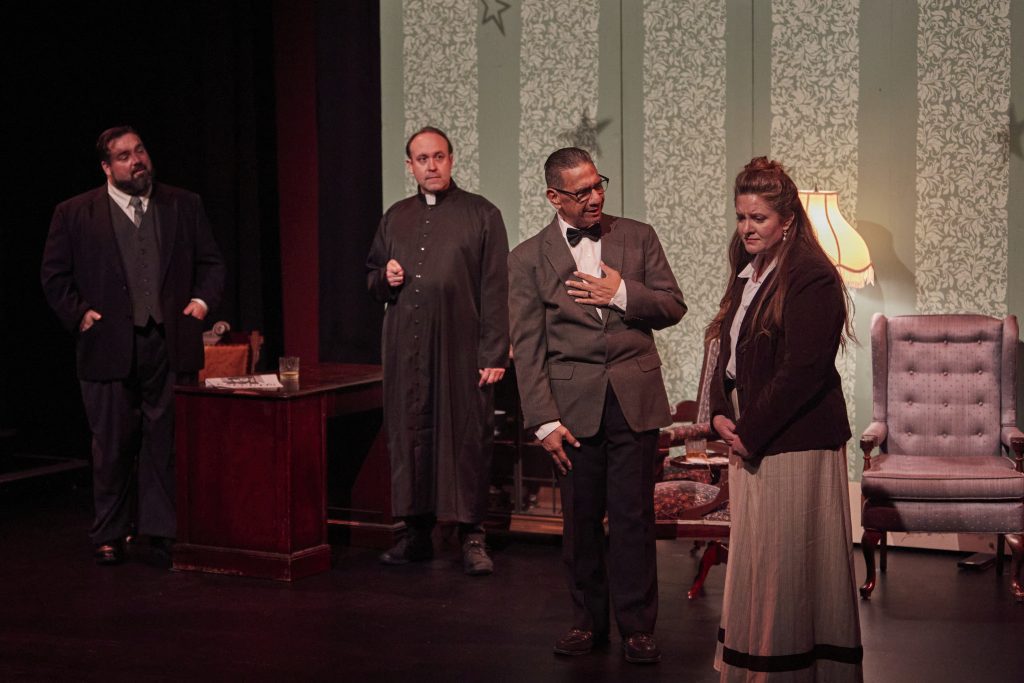An audience member reviews FATHER BROWN
Father Brown as a show has me quite torn. I’ve been familiar with all for One productions, both as an actor and as an audience member, for over 10 years now. Every once in a while, I will be in a show that I am so glad I was a part of; other times, I am perfectly fine enjoying it as an audience member, knowing there wasn’t a role for me in the show. However, every now and then I see a show that I feel so envious not to have played a direct part in, while simultaneously so glad I got to actually watch it and enjoy it from the outside.
Father Brown was one of those shows.
It gives me a pang watching some of these new (to me) faces playing such fun parts, along with familiar faces whom I’ve had the joy of working with previously, just absolutely slaying it up there on stage. The privilege to be on the stage bouncing energies off of actors like these in such intense (and often hysterical) scenes is something someone like me can only experience every so often. (That’s what it was like playing the titular Winnie the Pooh in afO’s last outing on the Main Stage.) Little did I know that I would be kicking myself for not auditioning for Father Brown. Little did I know that afO was going to knock it out of the park two times in a row with two very different shows.



So what is Father Brown? Father Brown has been many things, as Lauren Nichols explains in her director’s notes and dramaturgy: short stories by G.K. Chesterton, two different television series, and now an adaptation as a stage play. I had never heard of Father Brown before Lauren announced it for their 2024-2025 season. One thing I love about afO is how they can bring these stories I would have otherwise overlooked to the stage and surprise me with something a little bit special and something that not just anybody is doing. It feels like lightning in a bottle. If I want to see Elf the Musical, I can pretty reliably see it nearly every year some place. But with afO, if you miss one of their shows, you’re missing something novel and intimate that you can’t likely see anywhere else.
I had the privilege of watching Father Brown three separate times: Once during a normal run-through in the rehearsal room, with costumes and props, but without the lighting, sound effects or projections; then a week later on afO’s main stage (the PPG ArtsLab) with everything, including lights and sound cues; and finally one more time at the first Sunday afternoon matinee with a large and enthusiastic audience. As part of the Directors’ Apprenticeship program that afO’s artistic director Lauren Nichols is leading, she invited me to see these rehearsals and take notes and watch and learn and discuss my discoveries with her. Through this process I got to really dive into the material and gain an appreciation for the depth of each character and story element. I can distinctly remember a moment during the first rehearsal where my jaw dropped and my head was out of my notes and my eyes remained locked on the action as I let out an almost involuntary “no way”.
The show only got better every time I saw it. By the time I saw it a third time I was feeling anxious and giddy about each scene as it approached. Rather than becoming stale or boring, the show only got richer as I was able to keep returning to it. Right from the start, G.K. Chesterton’s title character, Father Brown, played cleverly by Andrew Rodenbeck, is caught up in a philosophical and theological discussion with a quite cynical fellow priest. Worldviews clash when Father Brown argues for the immutable nature of reason in a world governed by God who created reason and is Himself reasonable. Soon we find ourselves caught up in an investigation where Father Brown is called upon to help pursue a criminal on the run, the crafty Flambeau, portrayed by Timothy Deal who makes the character not only fun, but also brings an emotion and internal conflict to him, which Father Brown seeks to appeal to in his priestly way.
There is of course another man whom Father Brown finds himself in contention with, the chief inspector, Valentine, played by my friend Jeff Salisbury, whose sole ambition throughout the show is to see Flambeau captured and brought to justice. Jeff plays Valentine with such fire and pride. This is a man whose single-minded devotion to his craft keeps his eyes everywhere. He can’t bear letting anything go unnoticed and losing his chance to secure his man. Valentine finds out what it means to have a man of the cloth assisting in his work, as the means of solving the issue of Flambeau are very different to the two men. As clever as Father Brown is, his methods lean toward rehabilitation and salvation, whereas Valentine’s worldly perspective sees Flambeau as beyond the pale, beyond redemption. Once a criminal, always a criminal. This show is able to hold these tensions overhead: will Father Brown be able to reach out and grab at whatever goodness is inside Flambeau? Does Flambeau actually have what it takes to turn around and leave behind his life of crime? Is Father Brown doing more harm than good by being too lenient? Is he naive? Is he wise? Is Valentine going to prove all of Father Brown’s theories wrong and make God seem a fool to those who witness the outcome of all this? All of these questions permeate the show.
However, that is not all you’re in for when attending this play. The play is split into two acts, with about three chapters each, and four distinct crimes and investigations. There is always something new going on to keep things interesting. You may think at first that these vignettes seem to be veering off into events completely unrelated to the main crux of the story. But you’d be mistaken. There is not a wasted scene in this show. All of the stories feed into the themes and the overall message of the play, and provide audiences with more context around key characters, such as Father Brown and Valentine. We have time to get to know the larger community, such as the drunken Colonel Bohun and his saintly brother Reverend Bohun, the wealthy Laura Galloway and her lovestruck friend Margaret Stacey, and the chief inspector’s hilarious partner on the force, Officer O’Brien. All of these characters and their stories fill out the world and make it lively, with the assistance of some wonderful projections. The alley style of the staging allows for intimate scenes in a bakery on one side, and later a tension-filled confrontation in the inspector’s office on the other. Every part of the stage is utilized and you never get bored of any setting or any area of the stage. It’s a dynamic viewing experience.
Of course I can’t forget about the costumes. From the priestly garb of Father Brown to the handsome uniform of the stocky Officer O’Brien and the striking robes of Kalon, the worshipper of the sun, each character’s clothing perfectly represents them. One other element that truly elevated the material was the music, arranged specifically for this show by Janelle Deal with some guidance from Lauren Nichols, the director. There are three distinct character themes that usher you from one scene to the next gracefully. With incidental music created for this production, you can really feel a hand-crafted attention to maintaining the tone of the show throughout. It feels authentic to each scene and the experience we’ve just had, without telling you what to feel outright.



You will be doing yourself a disservice if you do not attend Father Brown. It will make you think, laugh, gasp, and maybe even tear up a bit. I know I did. It holds the balance of tone so neatly and never loses you by being too serious or too silly. There are a few scenes which include the closest thing to “gore” you might have seen at an afO production. (This includes decapitated heads in bags, and a corpse covered in blankets.) It is light and it is tasteful, just enough to let your imagination fill in a few blanks, but nothing you can’t bring older children to. Even as young as ten? I only have a two-year-old, so what do I know? Viewer discretion is advised and all that. That aside, see this show, even if you’re exploring this material for the first time as I did.
–Jadon Moore, 25 September 2024
Performances Sept 27, 28, 29
Friday/Saturday curtain 7:30 PM
Sunday matinee curtain 2:30 PM
Tickets are available online and at the door.
$22 adults, $19 seniors(60+), $15 students
